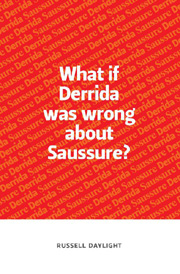Book contents
- Frontmatter
- Contents
- Acknowledgements
- Abbreviations and Textual Notes
- Introduction
- 1 Classical Semiology
- 2 The Originality of Saussure
- 3 The Concept of the Sign
- 4 Writing, Speech, and the Voice
- 5 The Sign as Representation
- 6 Linguistic Identity
- 7 The Sign and Time
- 8 The Horizon of Language
- Conclusion
- List of Works by Derrida and Saussure
- References
- Index
7 - The Sign and Time
Published online by Cambridge University Press: 12 September 2012
- Frontmatter
- Contents
- Acknowledgements
- Abbreviations and Textual Notes
- Introduction
- 1 Classical Semiology
- 2 The Originality of Saussure
- 3 The Concept of the Sign
- 4 Writing, Speech, and the Voice
- 5 The Sign as Representation
- 6 Linguistic Identity
- 7 The Sign and Time
- 8 The Horizon of Language
- Conclusion
- List of Works by Derrida and Saussure
- References
- Index
Summary
The lecture titled ‘Différance’ was first presented to the Société française de philosophie on 27 January 1968, and published in the Société's Bulletin in July 1968. In June 1968, in between the presentation of ‘Différance’ as a lecture and its first publication, Julia Kristeva interviewed Jacques Derrida for the journal Information sur les sciences sociales, which was later reprinted in Positions as ‘Semiology and Grammatology’. In this interview, Kristeva suggests to Derrida that: ‘Semiology today is constructed on the model of the sign and its correlates: communication and structure’ (Kristeva, qtd in S&G: 17). ‘Semiology and Grammatology’ itself is oriented towards questions of communication as the transport of pure signifieds, and hence towards the classical concept of the sign, the transcendental signified, and phono-logocentrism. In response to the question of structure, Derrida refers the reader to the essay ‘Différance’, and to the work of différance upon the theory of synchronic structure proposed by Saussure. This work is summarised in ‘Semiology and Grammatology’ as follows:
The activity or productivity connoted by the a of différance refers to the generative movement in the play of differences. The latter are neither fallen from the sky nor inscribed once and for all in a closed system, a static structure that a synchronic and taxonomic operation could exhaust. Differences are the ef ects of transformations, and from this vantage the theme of différance is incompatible with the static, synchronic, taxonomic, ahistoric motifs in the concept of structure. (S&G: 27)
- Type
- Chapter
- Information
- What if Derrida was wrong about Saussure? , pp. 130 - 146Publisher: Edinburgh University PressPrint publication year: 2011



